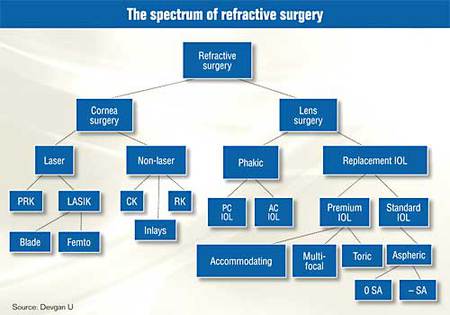Use full range of refractive surgery options to meet patients’ needs
Besides selecting the proper technology and procedure for each individual, ophthalmologists must also determine the postop refractive goal that will provide the most ideal vision.

The goal for refractive surgery patients is achieving sharp, high-quality vision at a variety of working distances while minimizing the need for glasses. To meet these desires, we have developed a full spectrum of refractive surgery options that allows us to individualize the treatment to the specific patient and his or her visual needs. It is important for surgeons to learn the full range of procedures to suit their patients’ needs. By having a full toolbox of options, we avoid the “one-size-fits-all” approach reflected in the saying, “If your only tool is a hammer, everything starts to look like a nail.”
Corneal-based refractive surgery
 Uday Devgan |
The mainstay of refractive surgery has been excimer laser ablation of the cornea, primarily in the forms of LASIK and PRK. This addresses the visual needs of most young, healthy eyes with mild to moderate degrees of myopia, hyperopia and astigmatism. It does not specifically provide a correction for presbyopia, although we can induce anisometropia in the postoperative results to create monovision and a larger range of vision. With the advent of new femtosecond lasers, the precision of creating corneal flaps has increased significantly when compared with microkeratomes.
There are nonlaser-based corneal corrections such as conductive keratoplasty, radial keratotomy and new corneal inlays. Although not yet approved by the U.S. Food and Drug Administration, the corneal inlays provide an interesting approach that may be somewhat reversible or upgradeable.
Corneal-based refractive surgery, such as LASIK and PRK, has limitations when it comes to high degrees of correction, as it may compromise corneal stability, is less predictable and can induce higher-order aberrations that may impair image quality.
Lens-based refractive surgery
The range of corrections possible with lens-based refractive surgery is far greater than corneal surgery, and patients with high degrees of myopia and hyperopia can be treated with excellent results and good image quality. William F. Maloney, MD, has been instrumental in teaching lens-based refractive surgery for many years and has solidified the concept of creating a custom postoperative result for each patient.
For younger patients, we can keep their crystalline lens intact and add a phakic IOL implant to correct their refractive error. These phakic IOLs can be placed in the posterior chamber or anterior chamber and are made of a variety of materials. The current FDA-approved lenses include the Visian ICL from STAAR Surgical and the Verisyse from Advanced Medical Optics, with multiple other products in development, including multifocal lenses to address presbyopia, as well.
For some presbyopic patients and for those with cataracts, replacement of the crystalline lens with a posterior chamber IOL implant may be the best option. Even extreme myopia and hyperopia can be addressed effectively with a replacement IOL. There is a full menu of IOLs available to correct astigmatism, spherical aberration and presbyopia. Selecting the right lens for the patient’s specific needs will become increasingly more complex as the menu grows larger. The ideal replacement IOL will be an accommodating lens that provides sharp vision at all distances without the need for glasses.

Tailoring the result to the patient
After we have selected the technology and procedure that best suits our patients’ needs, we need to determine the postoperative refractive goal that will provide the most ideal vision.
Does the patient want to optimize the focal length at a particular distance? Does the patient want both eyes to have the same refractive result or is a degree of monovision more suitable? The three primary questions that I ask the patient relate to the range of vision, the quality of vision and the ability to tolerate an interocular difference.
For example, a 55-year-old hyperopic and presbyopic architect who wants to sit at his drafting table and use a computer for 8 hours a day without glasses would benefit from accommodating IOLs with a mildly myopic postop refraction. But a similar patient who wants to maximize spectacle independence and spends more time doing leisure activities outdoors would be better suited for multifocal IOLs with a plano postop refraction. We can further increase the range of vision for both of these patients by creating a mild amount of interocular difference, making the dominant eye closer to plano and the nondominant eye somewhat more myopic.
Patients come in all varieties, and they have different needs for their vision. Incorporating the full spectrum of refractive surgery is integral to meeting patient expectations and delivering happiness.
For more information:
- Uday Devgan, MD, FACS, is in private practice at Devgan Eye Surgery in Los Angeles, Beverly Hills, and Newport Beach, California. Dr. Devgan is Chief of Ophthalmology at Olive View UCLA Medical Center and an Associate Clinical Professor at the Jules Stein Eye Institute at the UCLA School of Medicine. Dr. Devgan can be reached at 11600 Wilshire Blvd., Suite 200, Los Angeles, CA 90025; 800-337-1969; fax: 310-388-3028; e-mail: devgan@gmail.com; Web site: www.DevganEye.com. Dr.Devgan is a consultant to Abbott Medical Optics and Bausch & Lomb, and is a stockholder in Alcon Laboratories and formerly in Advanced Medical Optics.
